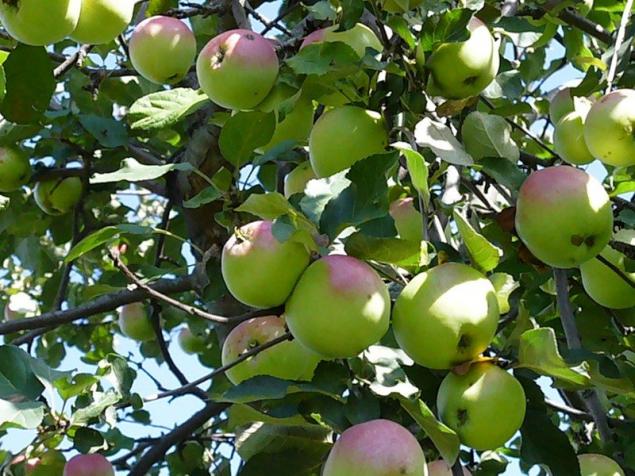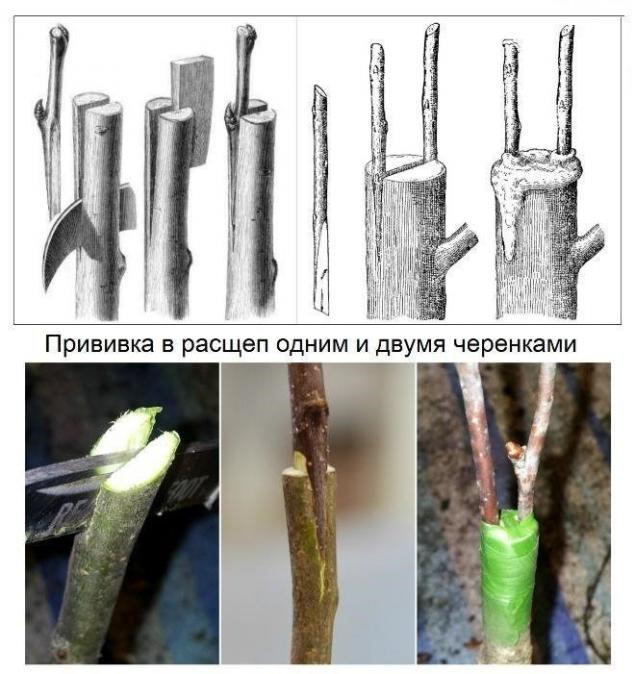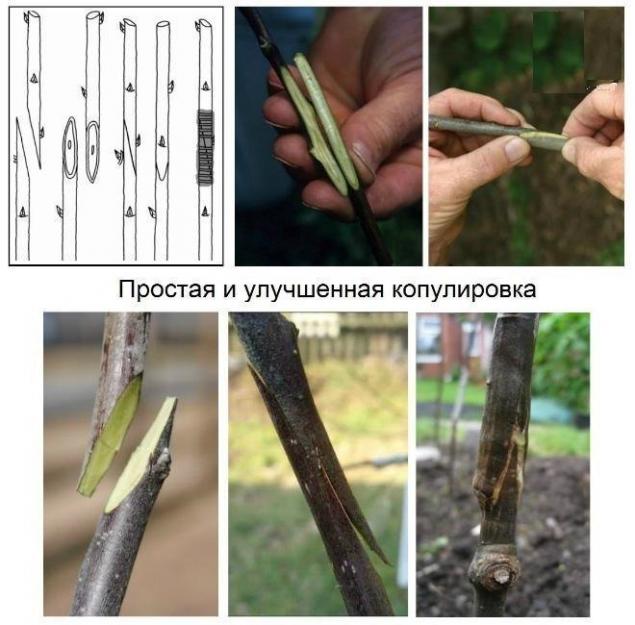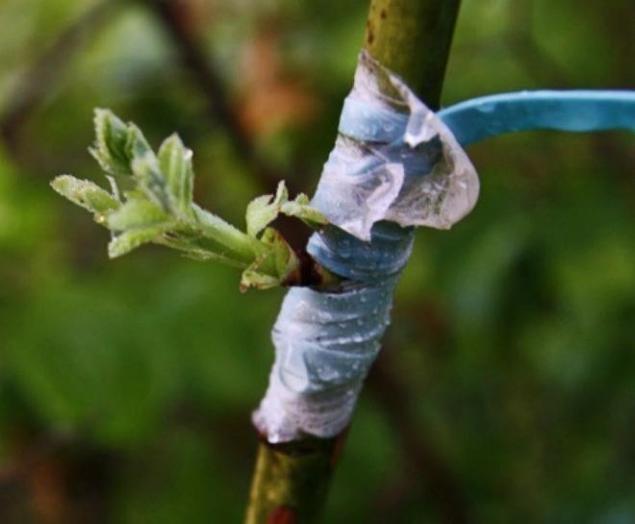How to graft an Apple tree
 Bashny.Net
Bashny.Net
Tips for beginners: how to plant an Apple treeSooner or later, the gardener raises the need for grafting Apple trees. Why do it?

The reasons may be several:
Grafting Apple trees in spring Spring is the most favorable time for grafting plants since the beginning of SAP flow scions are well acclimatized. Start inoculated cuttings early in the spring, in March and April when frosts are already asleep.
Budding (inoculation with Bud, or "eye") is carried out in April – early may.
The "spring" vaccinations are another significant advantage. If for some reason the scions do not root, you can try to graft an Apple tree in the summer without losing a year.
Grafting Apple trees in summer
At the end of July – beginning of August starts the second the SAP of fruit trees, so it is an ideal time to budding a dormant eye. In southern climates, in this way grafted Apple trees from late August to early September.
Grafting Apple trees in the autumn
In General, autumn is the best season for grafting. However, when warm weather in early September allowed the budding Apple trees "by eye".
In September and October you can also try the vaccine in other ways (in splitting, preklad, the bark). It is worth considering that at this time it is best accustomed scions on young stocks. Mature plants are autumn perepelica can hurt.
Ideally, inoculation by budding, or by the bark must be completed 2-3 weeks before the average temperature drops to the level of 15°C. However, if you live in southern latitudes where the first frost does not occur before the end of October – beginning of November, you can try to graft an Apple tree and in the middle of autumn.
Grafting Apple trees in winter
Vaccination is possible only in the winter indoors, so often it is called table grafting. This method is relevant for grafting of seedlings you plan to plant in the spring.
As a rule, saplings grafted from January to March, but not later than 15-20 days before planting in open ground.
It is worth considering that harvest the seedlings, rootstocks should fall before the frost, when the soil is still not frozen. Cuttings-cut off the scions, without waiting for the hard frosts, but when the temperature goes down to – 8°C.
Winter grafting success largely depends on proper storage of rootstocks and scions. Seedlings and cuttings are kept in the basement at a temperature of about 0°C. For 1-2 weeks before grafting the rootstock was transferred from the basement in a room with a temperature of 15-18°C. the Cuttings are transferred to a room for 2-3 days before the procedure.
The best methods of grafting Apple trees
There are many methods of grafting Apple trees. The most proven, which show the best results:
Budding Apple trees
Budding is a method of grafting young fruit trees "eye" (Bud). Depending on, you instill the Apple tree "sleeping" or germinating Bud, giving the vaccination in this way it is possible in spring or autumn.
Budding germinating eye is carried out in the early spring (late March or early April, depending on the temperature), when the tree, the first leaves. This method is recommended only in the southern regions, where the temperature is more or less stable.
In middle latitudes the most appropriate budding a dormant eye, which is held in late summer: from late July to early August.
The essence of this method of inoculation is that of the annual escape of the Scion is cut so-called "flap" (the kidney with the surrounding tissue) that is inserted into a T-shaped incision in the trunk (trunk) rootstock.

Grafting Apple trees in splitting
This grafting method is suitable for perepravki rootstocks, the trunk or skeletal branch which is about 2-5 cm in diameter (usually trees 3-6 years).
It is best to graft Apple trees in splitting in early spring, from March to April (depending on climate) when sleep cold, either from July to August, during the second SAP flow. In warmer latitudes this grafting method can be applied in the autumn, from September to early October.
During the vaccination the split at the trunk or skeletal branch of the Scion, make a split in the gap is inserted into the stem-girdling.
If the diameter of the rootstock is more than two times the diameter of the graft can be inserted into the split several scions: two or four.To plant four cuttings on the rootstock it is necessary to make a cruciform incision.

Topolyovka Apple
This grafting method can be used if the Scion and rootstock of the same thickness. Topolyovka most commonly used for inoculation of 1-2-year-old Apple trees. The diameter of the trunk (or skeletal branches) and cutting should be 2,5-5 cm
Such a vaccine can be applied in spring, summer and in the winter table grafting seedlings.
The essence of topolyovka is to connect Scion and rootstock in a single branch. The success of this grafting method depends on whether when you connect the cambium layers of the two branches. As a perfect connection between cambial layers is difficult enough, gardeners use a technique with improved topolyovka.
If there is a simple topolyovka on the Scion and rootstock are made oblique cuts, with improved topolyovka they are made longitudinal incisions depth of about 1 cm (the so-called "reeds"). Connect Scion and rootstock together in such a way that the "reeds" hooked to each other.

The best rootstocks for Apple
Perfect for rootstock cuttings of the tree can be considered to be seedlings of cultivated varieties of Apple trees or Mature trees. Inoculation of seedlings can be carried out on young "wildings" that you dug up in the woods or grown from seed.
What else you can graft an Apple tree? There are several alternatives stocks:
improved topolyovka;
in splitting;
in a side desperately;
the bark.
Care of grafted Apple tree:
Regardless of the grafting method after 10-15 days is necessary to check whether the engrafted Scion: dried kidney tissue on the stalk, delayed wound whether, in the case of budding – is it easy to separate the petiole from the panel.
If vaccination is not caught, the wound needs to gloss over garden pitch, and the vaccination should be repeated every spring or summer.
An important caveat in the care of grafted Apple tree in a timely manner to loosen the bandage at the site of inoculation, so it was not too tight and not damaged thread. If you plant an Apple tree in the spring or summer, the tape can be removed after 2-3 months. When autumn vaccination bandage left until spring until the snow melts.

It is equally important to remove the shoots that grow below the site of inoculation. They should be trimmed with a sharp knife, otherwise they will limit the power of the grafted cuttings. Break off the shoots, as they will begin to grow with renewed vigor.
If you plant an Apple tree in autumn, before the cold weather it is desirable to Spud well and water the tree to winter, the vaccine is not frozen. You also need to take care that only grafted Apple trees from the sun. After inoculation, if the weather is hot, it is recommended to shade the side of the tree, which conducted "operation".
After the graft has taken root and the buds have awakened, you need to trim. If the stalk appeared shoots from several buds, leave only one, the strongest of them (preferable to leave the escape from the top of the kidney). The lower escape is cut and the side – trim on the ring (almost to the skeletal branches of the rootstock).
When the young shoots from grafted cuttings reached a length of 20-25 cm, it is recommended to tie up. The second garter is carried out, when they will grow up to 40-50 cm Is required to do so, since the first 2-3 years after vaccination, the mechanical connection of the Scion and rootstock are not very strong.
During the first years after vaccination is especially important to water trees in hot dry weather and in a timely manner to feed them. Don't forget that wood is a living organism, and after the "surgery" it, like all living things, needs restoration.
As you can see, with a clear execution of the instructions successfully graft an Apple tree not too difficult. Good luck in horticultural experiments! published
P. S. And remember, just changing your mind — together we change the world! ©
Source: //vk.com/bg.garden?w=wall-83256494_40687

The reasons may be several:
- Apple trees on your plot bring meager harvest, and you would like to perepravit them to replace the crown of old trees more valuable grade.
- You are driven by the desire to experiment and try to grow on the same rootstock, several varieties of apples.
- You want to save some space on the site (instead of two Apple trees, you can do one, on which are grafted two different varieties of apples).
- You decide to grow a seedling Apple themselves, and not to buy it at the nursery ("Refine" wildings cultural Scion).
- The tree is severely damaged (e.g., rodents) and you want to save it with perepravki.
- More sensitive varieties of Apple trees must be grafted onto hardy rootstock to increase their frost resistance.
- You want to grow a dwarf Apple tree.
Grafting Apple trees in spring Spring is the most favorable time for grafting plants since the beginning of SAP flow scions are well acclimatized. Start inoculated cuttings early in the spring, in March and April when frosts are already asleep.
Budding (inoculation with Bud, or "eye") is carried out in April – early may.
The "spring" vaccinations are another significant advantage. If for some reason the scions do not root, you can try to graft an Apple tree in the summer without losing a year.
Grafting Apple trees in summer
At the end of July – beginning of August starts the second the SAP of fruit trees, so it is an ideal time to budding a dormant eye. In southern climates, in this way grafted Apple trees from late August to early September.
Grafting Apple trees in the autumn
In General, autumn is the best season for grafting. However, when warm weather in early September allowed the budding Apple trees "by eye".
In September and October you can also try the vaccine in other ways (in splitting, preklad, the bark). It is worth considering that at this time it is best accustomed scions on young stocks. Mature plants are autumn perepelica can hurt.
Ideally, inoculation by budding, or by the bark must be completed 2-3 weeks before the average temperature drops to the level of 15°C. However, if you live in southern latitudes where the first frost does not occur before the end of October – beginning of November, you can try to graft an Apple tree and in the middle of autumn.
Grafting Apple trees in winter
Vaccination is possible only in the winter indoors, so often it is called table grafting. This method is relevant for grafting of seedlings you plan to plant in the spring.
As a rule, saplings grafted from January to March, but not later than 15-20 days before planting in open ground.
It is worth considering that harvest the seedlings, rootstocks should fall before the frost, when the soil is still not frozen. Cuttings-cut off the scions, without waiting for the hard frosts, but when the temperature goes down to – 8°C.
Winter grafting success largely depends on proper storage of rootstocks and scions. Seedlings and cuttings are kept in the basement at a temperature of about 0°C. For 1-2 weeks before grafting the rootstock was transferred from the basement in a room with a temperature of 15-18°C. the Cuttings are transferred to a room for 2-3 days before the procedure.
The best methods of grafting Apple trees
There are many methods of grafting Apple trees. The most proven, which show the best results:
- budding (Bud grafting);
- vaccination in the splitting;
- topolyovka.
- in polurama;
- for the crust;
- in a side desperately;
- bridge (for trees with damaged bark);
- ablative (inoculation convergence).
Budding Apple trees
Budding is a method of grafting young fruit trees "eye" (Bud). Depending on, you instill the Apple tree "sleeping" or germinating Bud, giving the vaccination in this way it is possible in spring or autumn.
Budding germinating eye is carried out in the early spring (late March or early April, depending on the temperature), when the tree, the first leaves. This method is recommended only in the southern regions, where the temperature is more or less stable.
In middle latitudes the most appropriate budding a dormant eye, which is held in late summer: from late July to early August.
The essence of this method of inoculation is that of the annual escape of the Scion is cut so-called "flap" (the kidney with the surrounding tissue) that is inserted into a T-shaped incision in the trunk (trunk) rootstock.

Grafting Apple trees in splitting
This grafting method is suitable for perepravki rootstocks, the trunk or skeletal branch which is about 2-5 cm in diameter (usually trees 3-6 years).
It is best to graft Apple trees in splitting in early spring, from March to April (depending on climate) when sleep cold, either from July to August, during the second SAP flow. In warmer latitudes this grafting method can be applied in the autumn, from September to early October.
During the vaccination the split at the trunk or skeletal branch of the Scion, make a split in the gap is inserted into the stem-girdling.
If the diameter of the rootstock is more than two times the diameter of the graft can be inserted into the split several scions: two or four.To plant four cuttings on the rootstock it is necessary to make a cruciform incision.

Topolyovka Apple
This grafting method can be used if the Scion and rootstock of the same thickness. Topolyovka most commonly used for inoculation of 1-2-year-old Apple trees. The diameter of the trunk (or skeletal branches) and cutting should be 2,5-5 cm
Such a vaccine can be applied in spring, summer and in the winter table grafting seedlings.
The essence of topolyovka is to connect Scion and rootstock in a single branch. The success of this grafting method depends on whether when you connect the cambium layers of the two branches. As a perfect connection between cambial layers is difficult enough, gardeners use a technique with improved topolyovka.
If there is a simple topolyovka on the Scion and rootstock are made oblique cuts, with improved topolyovka they are made longitudinal incisions depth of about 1 cm (the so-called "reeds"). Connect Scion and rootstock together in such a way that the "reeds" hooked to each other.

The best rootstocks for Apple
Perfect for rootstock cuttings of the tree can be considered to be seedlings of cultivated varieties of Apple trees or Mature trees. Inoculation of seedlings can be carried out on young "wildings" that you dug up in the woods or grown from seed.
What else you can graft an Apple tree? There are several alternatives stocks:
- Rowan;
- Aronia (chokeberry);
- hawthorn;
- Kalina;
- quince;
- pear.
- These vaccinations are very durable compared to classic grafting Apple tree to Apple tree.
- To chokeberry tree survives worse than the red mountain ash (common).
- Rowan rootstock gives the tree winter hardiness, but due to this "relationship" the fruits can grow shallow. This same problem applies to Apple trees grafted on the hawthorn, viburnum and quince.
- An Apple tree on the quince can be grafted as an experiment, as the probability that the graft will continue to heal and will bear fruit abundantly, not very high.
- Pear great root on an Apple rootstock, but she "accepts" the scions of the tree worse. Therefore, such a vaccine should also be considered as a horticultural experiment.
Despite all the "but," grafting Apple trees on alternative rootstocks are often used by gardeners. Especially when there is a choice: to cut unnecessary Rowan or try to impart her valuable Apple varieties.
improved topolyovka;
in splitting;
in a side desperately;
the bark.
Care of grafted Apple tree:
Regardless of the grafting method after 10-15 days is necessary to check whether the engrafted Scion: dried kidney tissue on the stalk, delayed wound whether, in the case of budding – is it easy to separate the petiole from the panel.
If vaccination is not caught, the wound needs to gloss over garden pitch, and the vaccination should be repeated every spring or summer.
An important caveat in the care of grafted Apple tree in a timely manner to loosen the bandage at the site of inoculation, so it was not too tight and not damaged thread. If you plant an Apple tree in the spring or summer, the tape can be removed after 2-3 months. When autumn vaccination bandage left until spring until the snow melts.

It is equally important to remove the shoots that grow below the site of inoculation. They should be trimmed with a sharp knife, otherwise they will limit the power of the grafted cuttings. Break off the shoots, as they will begin to grow with renewed vigor.
If you plant an Apple tree in autumn, before the cold weather it is desirable to Spud well and water the tree to winter, the vaccine is not frozen. You also need to take care that only grafted Apple trees from the sun. After inoculation, if the weather is hot, it is recommended to shade the side of the tree, which conducted "operation".
After the graft has taken root and the buds have awakened, you need to trim. If the stalk appeared shoots from several buds, leave only one, the strongest of them (preferable to leave the escape from the top of the kidney). The lower escape is cut and the side – trim on the ring (almost to the skeletal branches of the rootstock).
When the young shoots from grafted cuttings reached a length of 20-25 cm, it is recommended to tie up. The second garter is carried out, when they will grow up to 40-50 cm Is required to do so, since the first 2-3 years after vaccination, the mechanical connection of the Scion and rootstock are not very strong.
During the first years after vaccination is especially important to water trees in hot dry weather and in a timely manner to feed them. Don't forget that wood is a living organism, and after the "surgery" it, like all living things, needs restoration.
As you can see, with a clear execution of the instructions successfully graft an Apple tree not too difficult. Good luck in horticultural experiments! published
P. S. And remember, just changing your mind — together we change the world! ©
Source: //vk.com/bg.garden?w=wall-83256494_40687
Tags
grafting Apple trees
Care of grafted Apple tree
topolyovka
rootstocks for Apple tree
Grafting Apple trees in splitting
See also
How to sit to avoid back pain
How to defend the water to remove chlorine
How to take a bath
Low back pain: how to sit, stand, and lift heavy
How to create a fan-shaped crown in the stone
How to do anti-cellulite vacuum massage
How to wash down jacket
How to grafted onto one Apple tree several varieties (agronomist)
Garden life hack: How to graft an Apple tree

















